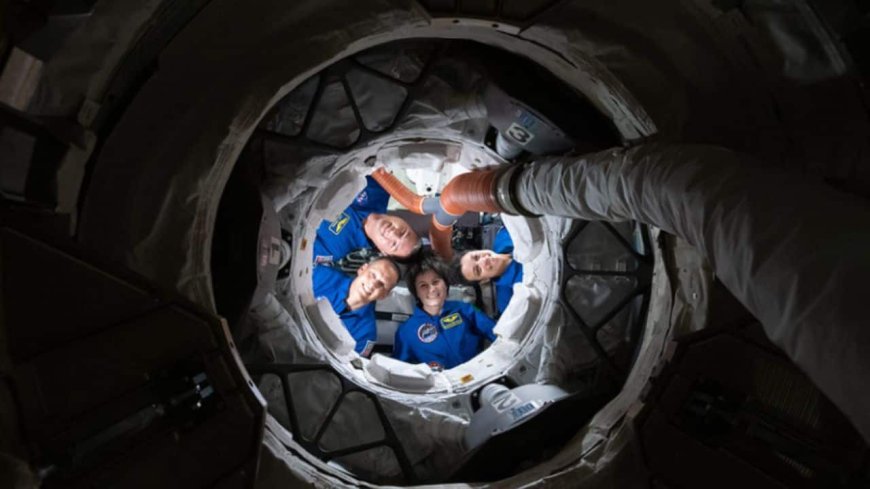Understanding How Space Affects the Human Body: Insights from NASA
Discover what NASA has learned about the impact of space travel on astronauts' health and well-being. From radiation exposure to gravity changes, explore the challenges faced by space travelers and how NASA is preparing for future missions to the Moon and Mars.

Clockwise from bottom, Expedition 67 Flight Engineers Samantha Cristoforetti, Bob Hines, Kjell Lindgren, and Jessica Watkins, squeeze inside Boeing’s CST-100 Starliner spacecraft, which transports astronauts to the space station. (Image: NASA)
Picture living where there is no gravity, no fresh air, and no sunshine coming through a blue sky. That is what astronauts experience as they leave for space, away from home. Protecting humans from harm and keeping them healthy outside Earth is not only a challenge but also a mission NASA has been refining for more than 50 years.
NASA's Human Research Program has researched what happens to the human body in space. What they do informs safer spacecraft designs, smarter spacesuits, and improved medical procedures. Researchers concentrate on keeping astronauts healthy, robust, and ready mentally during extended missions.
This study is even more critical as NASA prepares for the Moon and Mars. The Artemis mission will place the first woman and the next man on the lunar surface. This time, astronauts will venture further than ever before on the Moon while remaining protected.
NASA is particularly interested in long-duration missions beyond Earth. Astronauts such as Scott Kelly and Christina Koch have already spent almost a year in space. Their missions provided valuable insight into the effects on both mind and body of being in space.
Scott Kelly even participated in the legendary Twins Study. As Scott travelled around Earth, his twin Mark Kelly remained on Earth. By comparing the two, scientists gained unusual insight into the effects of space travel on health over time.
NASA keeps researching how the body handles longer journeys. The intention is obvious—to ensure that astronauts can survive and flourish on Mars and on journeys that last years.
The Five Largest Risks for Space Travelers
NASA has listed the five largest dangers to humans in space. The difficulties are categorised under the term \"RIDGE\": radiation, isolation, distance, gravity changes, and hostile environments.
Radiation is a massive issue once the astronauts travel beyond Earth's cover. Space lacks a magnetic field or dense atmosphere to shield against hazardous rays. Solar particles and galactic cosmic rays are threatening in their nature. Prolonged exposure may cause cancer, heart disease, or cataracts.
Protection against space radiation isn't simple. Certain particles are almost impossible to deflect. NASA employs sophisticated radiation detectors and shielding materials to limit exposure. Research on Earth using simulated cosmic rays allows scientists to estimate risks and enhance defences.
Confinement and isolation are among the more serious hazards. Space travellers share small environments for years or months at a time. This influences sleep, mood, and mental well-being. Crews have to manage stress, isolation, and cultural differences without losing their composure.
NASA uses tools like LED lighting, sleep monitors, and virtual reality to help astronauts cope. They also track mood, stress levels, and team dynamics closely. Space gardens, exercise, and meaningful tasks help crews stay focused and positive.
Distance from Earth creates special challenges. On the space station, assistance is just hours away. On Mars, communication lag is as much as 20 minutes each way. Astronauts have to fix things without immediate mission control guidance.
That requires taking everything they might need—tools, medical equipment, and several years' worth of food. NASA is experimenting with smart medical systems, AI-assisted decision support, and long-term medications in preparation.
Life Without Gravity and the Hidden Dangers
Gravity, or the absence of it, is perhaps the biggest obstacle. Astronauts must go through three gravity changes on a Mars mission—weightlessness in space, one-third gravity on Mars, and normal gravity back on Earth. Each change impacts balance, vision, and bodily systems.
Bones lose strength and muscles atrophy without ongoing weight-bearing exercise. Body fluids relocate upwards, exerting pressure on the eyes. Thigh cuffs and negative pressure suits have been developed by NASA to manage fluid movement.
Functional tests see if astronauts are able to stand, balance, or work after gravity shifts. Drugs such as potassium citrate decrease kidney stone risks. Special diets are accompanied by resistance exercises and even spinal scans to monitor bone and muscle health.
Closed environments also affect health, according to NASA. The air in a spacecraft has to remain flawless. Microbes easily spread in close environments. Isolation and stress can lower the immune system.
NASA monitors air for harmful gases and keeps a close watch on microbial growth. Crews take regular samples from surfaces, water, and even their own bodies to track health risks. Quarantine before launch and vaccinations help prevent illness.
Blood and saliva tests show the impact of space on immunity. Tests indicate that astronauts do not typically catch illnesses in space, but immune system changes remain a worry. Studies consider how long-duration space travel could cause autoimmune issues.
Homes are planned for comfort, security, and effectiveness. New lighting simulates Earth's natural day-night cycles. This assists in sleep regulation and maintaining mental health.
Reaching for the Moon and Mars with Confidence
NASA's years of study are paving the way for how future missions will be operated. All discovery from space station research and Earth simulations goes into planning for the Moon and Mars.
The Artemis missions will collect additional health information as astronauts return to the lunar surface. These learnings will lay the foundation for deep space travel that keeps astronauts not only alive—but thriving.
Space can be severe and merciless. But thanks to decades of innovation, humankind is preparing to travel further than ever before, with safety, health, and resilience at the centre of every mission.
What's Your Reaction?
 Like
0
Like
0
 Dislike
0
Dislike
0
 Love
0
Love
0
 Funny
0
Funny
0
 Angry
0
Angry
0
 Sad
0
Sad
0
 Wow
0
Wow
0





























































































































































